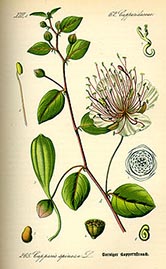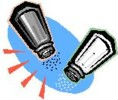Make the most of culinary herbs and spices.
Other articles you might enjoy:
2. Saffron Takes White Rice to Exquisite
3. Elegant Eggplant Steals the Show
4. Compound Butters Rescue Plain Foods
Capers Uncovered
by Sandra Bowens
Here's one that's full of our favorite recipes because we wrote the book! It is also full of information, helpful hints and ideas for using herbs and spices in your kitchen.

What is a caper? Where do they come from? How do I use them? These are all common questions asked about capers. Let's start at the beginning.
What is a caper?
These small green spheres are the unopened flower bud of a Mediterranean bush, Capparis spinosa. Closely related to the cabbage family, the shrubby plant resembles a rose bush. Each bud is picked by hand in the early morning hours before it can open. Capers are harvested daily from May to July. They have no great taste appeal when eaten fresh but after pickling they take on a pungent flavor.
After drying the buds in the sun, they are pickled in a strong vinegar brine. Most are bottled in this brine but they may also be packed in salt. This salt-pack method is far superior for maintaining quality and flavor. In her book, From Julia Child's Kitchen, Mrs. Child suggests replacing half of the brine in a jar of capers with vermouth to improve their flavor.
Where do capers come from?
Although they are grown throughout the Mediterranean as well as parts of Africa and Asia, the finest capers are said to be the tiny nonpareille (meaning 'without peer') that come from southern France. Capers range in size from this especially small variety to much larger ones from Italy. Morocco is the largest commercial producer today.
A new variety of capers from Spain is emerging on the market as "caperberries." The smaller the better has long been a mantra with capers but these caperberries are the size of olives. Packed with the stem intact, they are an elegant addition to a buffet with roasted fowl or poached fish.
How do I use capers?
Capers can be used in a variety of sauces, salads and meat or fish dishes. They lend a mild peppery, pickled taste when added to a recipe or served along side as a garnish.
You should rinse capers before using to wash away any saltiness. You may wish to coarsely chop the larger varieties but this really isn't necessary.
Experiment with capers in their various sizes and in different recipes to decide what you like the best. You might add them to tuna salad or try sprinkling a few capers on your next pizza. Or add them to a chunky tomato sauce and serve it over fish.
Check the indexes of your cookbooks for other uses. Look especially for tapenade, a pungent spread made of capers, olives and anchovies. Also look for recipes that call for capers such as mustard sauces or mayonnaise variations.
Or try the following recipe inspired by a salad I had at the local Macaroni Grill. It's a great combination that will improve after a day or two in the refrigerator, if it lasts that long.
Shrimp and Spinach Salad with Lemon Vinaigrette Dressing
6 ounces spinach leaves, well-washed and torn into small pieces
12 sun-dried tomato halves, cut into thin strips
4 green onions, sliced 2 inches into green part
1/4 cup small capers, rinsed
1/4 cup toasted pine nuts
1 pound cooked shrimp (grilled is especially nice)
Shaved Parmesan cheese
Lemon Vinaigrette Dressing, recipe follows
Combine all ingredients except the cheese and dressing in a large salad bowl. Pour dressing over salad and toss gently but well. Sprinkle with cheese and serve right away.
Makes 4 generous servings
Lemon Vinaigrette Dressing
1 lemon, zested then juiced
1/3 cup extra virgin olive oil
2 Tablespoons white wine vinegar
1/2 teaspoon granulated garlic
Plenty of salt and freshly ground black pepper
Shake all ingredients in a small jar with a lid. Taste and adjust seasonings, if necessary. Makes about 2/3 cup dressing.

Authentic yet modern Middle Eastern cooking at your fingertips and arranged in alphabetical order at that.
Go home with the Herbfarm's award-winning chef as he shows you how to prepare these simple yet utterly delightful recipes.




